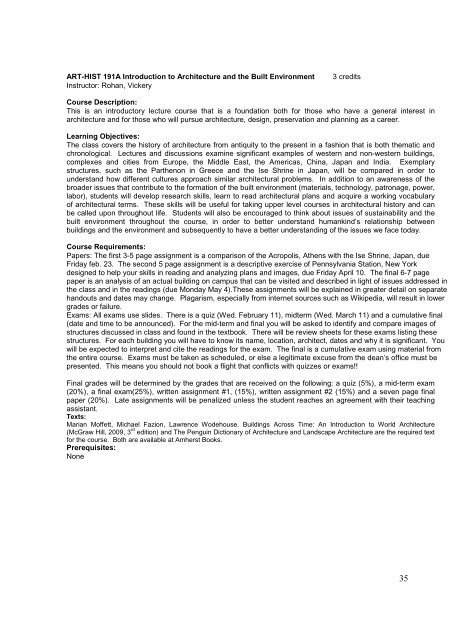architecture program report - University of Massachusetts Amherst
architecture program report - University of Massachusetts Amherst
architecture program report - University of Massachusetts Amherst
You also want an ePaper? Increase the reach of your titles
YUMPU automatically turns print PDFs into web optimized ePapers that Google loves.
ART-HIST 191A Introduction to Architecture and the Built Environment 3 credits<br />
Instructor: Rohan, Vickery<br />
Course Description:<br />
This is an introductory lecture course that is a foundation both for those who have a general interest in<br />
<strong>architecture</strong> and for those who will pursue <strong>architecture</strong>, design, preservation and planning as a career.<br />
Learning Objectives:<br />
The class covers the history <strong>of</strong> <strong>architecture</strong> from antiquity to the present in a fashion that is both thematic and<br />
chronological. Lectures and discussions examine significant examples <strong>of</strong> western and non-western buildings,<br />
complexes and cities from Europe, the Middle East, the Americas, China, Japan and India. Exemplary<br />
structures, such as the Parthenon in Greece and the Ise Shrine in Japan, will be compared in order to<br />
understand how different cultures approach similar architectural problems. In addition to an awareness <strong>of</strong> the<br />
broader issues that contribute to the formation <strong>of</strong> the built environment (materials, technology, patronage, power,<br />
labor), students will develop research skills, learn to read architectural plans and acquire a working vocabulary<br />
<strong>of</strong> architectural terms. These skills will be useful for taking upper level courses in architectural history and can<br />
be called upon throughout life. Students will also be encouraged to think about issues <strong>of</strong> sustainability and the<br />
built environment throughout the course, in order to better understand humankind’s relationship between<br />
buildings and the environment and subsequently to have a better understanding <strong>of</strong> the issues we face today.<br />
Course Requirements:<br />
Papers: The first 3-5 page assignment is a comparison <strong>of</strong> the Acropolis, Athens with the Ise Shrine, Japan, due<br />
Friday feb. 23. The second 5 page assignment is a descriptive exercise <strong>of</strong> Pennsylvania Station, New York<br />
designed to help your skills in reading and analyzing plans and images, due Friday April 10. The final 6-7 page<br />
paper is an analysis <strong>of</strong> an actual building on campus that can be visited and described in light <strong>of</strong> issues addressed in<br />
the class and in the readings (due Monday May 4).These assignments will be explained in greater detail on separate<br />
handouts and dates may change. Plagarism, especially from internet sources such as Wikipedia, will result in lower<br />
grades or failure.<br />
Exams: All exams use slides. There is a quiz (Wed. February 11), midterm (Wed. March 11) and a cumulative final<br />
(date and time to be announced). For the mid-term and final you will be asked to identify and compare images <strong>of</strong><br />
structures discussed in class and found in the textbook. There will be review sheets for these exams listing these<br />
structures. For each building you will have to know its name, location, architect, dates and why it is significant. You<br />
will be expected to interpret and cite the readings for the exam. The final is a cumulative exam using material from<br />
the entire course. Exams must be taken as scheduled, or else a legitimate excuse from the dean’s <strong>of</strong>fice must be<br />
presented. This means you should not book a flight that conflicts with quizzes or exams!!<br />
Final grades will be determined by the grades that are received on the following: a quiz (5%), a mid-term exam<br />
(20%), a final exam(25%), written assignment #1, (15%), written assignment #2 (15%) and a seven page final<br />
paper (20%). Late assignments will be penalized unless the student reaches an agreement with their teaching<br />
assistant.<br />
Texts:<br />
Marian M<strong>of</strong>fett, Michael Fazion, Lawrence Wodehouse. Buildings Across Time: An Introduction to World Architecture<br />
(McGraw Hill, 2009, 3 rd edition) and The Penguin Dictionary <strong>of</strong> Architecture and Landscape Architecture are the required text<br />
for the course. Both are available at <strong>Amherst</strong> Books.<br />
Prerequisites:<br />
None<br />
35

















